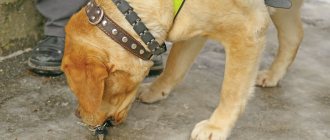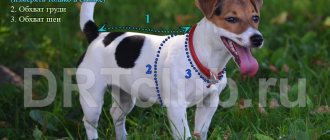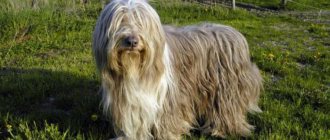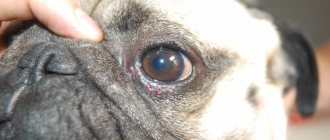What is agility
What epithets come to mind when we think about dogs - agile, fast, jumping. Agility is a sport in which all these qualities of a dog are revealed more than anywhere else. The word “agility” is translated from English - speed, dexterity.
Agility competitions involve the participation of not only the dog itself, but also the owner or his representative. The person performing with the dog is called the handler. He guides the animal on the obstacle course, helps with commands, and corrects behavior.
The competition itself takes place in the form of an obstacle course. This is another plus for the popularity of agility, because such competitions are quite easy to organize. Typically obstacle courses should be 200 meters long. Obstacles are located on them every 10 meters.
The strip may not be straight, but in any form that the organizers come up with. This loading of obstacles allows not only the handler and his ward, but also the spectators, of whom there are many, to enjoy the process.
Agility classes
The use of various obstacles, as well as the variation of errors and violations, make it possible to divide Agility into several classes, the number and type of which are regulated by judges of different organizations.
Today the main classes include:
- Class “Standard” – represented by a numbered obstacle course on which obstacles of each type are located. Beginners compete on a course with fifteen obstacles, high-level competitions involve approximately twenty obstacles;
- The “Jumping” class is represented by a numbered obstacle course that includes various projectiles for jumping. Sometimes competition organizers include slaloms and various tunnels as additional equipment;
- Class "Joker or Jackpot" - represented by an unnumbered obstacle course consisting of an introductory and final part. In the first period, the pet overcomes obstacles selected by the handler within a certain time period and accumulates points, and in the second part of the competition, an obstacle selected by the judge is passed;
- The Snooker class is based on the famous billiard game, and the obstacle course consists of at least three red obstacles to jump over and six other obstacles, through which the pet gains points in accordance with the number of the obstacle. The dog passes the jumping apparatus, and then any of the six. This sequence is repeated three times;
- “Relay” class – several “handler-dog” teams participate, which alternately perform part of the “Standard” class with the passing of the baton. Teams are usually formed according to the experience and size of the pets.
Return to content
History of appearance
Since its inception, agility has been simply entertainment for spectators. At one of the dog shows in Great Britain, one of the organizers, John Varley, made an attempt to entertain the spectators. He wanted to show something that no one had offered before that moment. He was assisted by his friend Peter Meanwell.
Since both were fond of equestrian sports, it occurred to them to take the obstacle course as a basis from there. Some elements and obstacles were copied. Something was invented additionally, specifically for the dog.
In 1978, at an exhibition, friends first presented such entertainment to the attention of viewers. Everyone was delighted. Such competitions were repeated the next year, at another exhibition.
After a short amount of time, agility was officially recognized as one of the sports.
In Russia, the first agility championship was held in 1994. The number of participants for our huge country was very small - only 12 couples. The following year, the Russian Cup was held, the importance of the competition was emphasized by the fact that Jean Paul Petididier, the chairman of agility in the FCI sports committee, acted as the chief judge. Since 1996, Russian teams have been regular participants in the World Agility Championships.
Dogs participants
Another advantage of agility is its complete openness to dogs of all breeds. It would be more accurate to say that outbred dogs can also take part. There are no admissions in the form of pedigree or other evidence of the breed.
But restrictions still exist, although they are advisory in nature:
- age. In agility competitions, it is better to enter an animal over a year old. The skeleton of such animals and their psyche have been formed. This will help protect you from injury on the obstacle course. It is better not to bring your puppy to competitions;
- pregnancy. Pregnant bitches are not allowed to participate;
- training. Dogs must be able to comply with the handler's demands, know basic commands and be able to overcome obstacles.
Although the breed does not matter, it has been observed from experience that agility is best suited for herding breed dogs.
For convenience and for equality of tailed participants, they are divided into categories:
- “S” - small - less than 35 cm at the withers;
- “M” - medium - 35-43 cm at the withers;
- “L” – large – from 43 cm at the withers.
The competition begins with participants from the S category, then the other two in succession. This happens because some equipment on the obstacle course are adjusted specifically to the height of the participant. For example, the height of the barrier.
Based on the experience of holding competitions, certain dog breeds have already emerged that most often become winners in their categories. In the “small” category, the most successful dogs are the Spitz breed, in the “medium” Sheltie, and in the “large” category – the Border Collie. Border collies are very fast dogs. Many breeders use a trick and breed a Border Collie dog with a height that allows it to compete in overcoming obstacles in the smallest category, where it is among the leaders.
Rules for agility competitions
The conduct of agility competitions at the international level is determined by the rules of the Fédération Cynologique Internationale (FCI), on the basis of which each country develops its own national rules. In the Russian Federation, agility competitions are held on the basis of the rules of the Russian Canine Federation (RKF), however, each kennel club can introduce some nuances into the rules that do not contradict the basic ones.
Agility sections
The division into two main sections of the discipline occurs depending on the method of interaction with obstacles.
- Jumping - the track consists of non-contact projectiles that the dog must jump over (you cannot touch them);
- Agility itself is a course consisting of contact obstacles over which the dog must pass or run, as well as non-contact equipment.
Categories of dogs in agility
Dogs for competition are divided into categories based on height:
- S (small) - height at the withers is less than 35 cm;
- M (medium) - height from 35 to 43 cm;
- L (large) - 43 cm and above.
Competitions are held separately for each category to ensure equal conditions for all animals.
Passing the route
The rules regulate the sizes of all projectiles (they even contain drawings for constructing obstacles).
The task of the competition participants is to pass all the equipment on the course as quickly and accurately as possible in the correct order.
The control (reference) and maximum (maximum permissible for completing the route) time is determined depending on the complexity of the route and the conditions of the competition.
For mistakes made by participants on the route and exceeding the control time allotted for completing the route, penalty points are awarded.
Jack Russell Terrier makes mistakes when passing the track (video)
Also, for a number of violations committed by participants on the track, the judge can disqualify them (remove them from the track). For example, while passing the route you cannot:
- the handler should touch the dog and/or equipment, as well as jump over or step over obstacles;
- the dog performing while wearing a collar and/or leash;
- reward the dog (with treats, toys or other means);
- the handler should hold something in his hands, and also have with him objects that attract the dog’s attention (whistle, leash, food, etc.);
- exceed the maximum time;
- skip obstacles.
What shells are used
The International Canine Association has established the types of equipment that are used in agility. The main requirement is safety for the pet. The organizers themselves can mix them on the obstacle course in any order. It is allowed to install obstacles in any way.
All projectiles are divided into two groups:
- Assume contact with the participant;
- Does not involve contact.
Contact
- "Slide". Two planes connected in the form of an inverted “V”, the highest point is at a height of 1.5-2 meters from the ground. Wooden strips parallel to each other are attached to them, providing an anti-slip effect. The handler gives the command: “Home”, “Slide”.
- "Swing". Similar to a children's swing, on which two people ride, located at different ends. At the moment when the pet begins to move along the projectile, one of the sides moves down and the handler gives the command to move: “Swing”;
- "Boom". Unusual slide. The difference is that the shields are not connected at an angle. And between them there is a wide board along which the pet must run. In some ways the apparatus resembles a gymnastic beam. They give the command: “Boom”;
- "Tunnel". The obstacle looks like a wide pipe. The tunnel can be soft or hard. Positioned differently on the obstacle course. They give the command: “Tun” or “Bottom.”
Contactless
- "Barrier". The projectile is designed according to the principle used by track and field athletes. Two supports with a transverse bar, which is knocked down if necessary, so as not to injure the animal in the process of overcoming obstacles. The dog must pass the barrier without knocking down the bars. Command: “Jump”, “Up”, “Hop”;
- "Ring". The point of overcoming the projectile is for the dog to jump through a ring fixed to the posts. Team: “Circle”, “Tire”, “Bar”.
- "Bounce". Jumps must be performed by the dog on command, over several obstacles at once. Command: “Hop”, “Jump”, “Up”;
- "Slalom". The animal must run around twelve obstacles in the form of racks located strictly along the line. The passage is a snake. Command: "Trrr";
- "Podium-square". A square-shaped area located at a height specified for different categories, from 2 to 75 cm. The dog must jump onto this square and fixate there for a certain time: “Hop”.
Types of obstacles in agility
There are no uniform strict standards in agility for obstacles, their number, size of areas and length of the track. the agility championship includes can be divided into the following main groups:
- contact areas to overcome;
- jumping barrier zones;
- areas of additional obstacles.
An additional obstacle zone can help improve the results shown in the main zones, or, conversely, worsen them. The types of equipment displayed in it and their order are almost always unknown in advance to the animal owners, which makes it possible to maximize the “coherence” and readiness for surprises of the competing “dog-human” teams.
Contact obstacles
Contact obstacle areas typically include the following:
- slide;
- transition;
- swing;
- boom;
- tunnel.
The slide is two wooden panels, each about a meter wide and about three meters long. They are put together as a “house”. The height above the ground in the center of the obstacle is equal to 1.5-2 meters, that is, the angle of inclination is quite steep.
The lower part of the shields is painted in a bright color, usually yellow, red or orange, this is not done for beauty, but so that the animal “marks” the beginning of the passage of the projectile by touching it with its paw, and the judges can notice it.
Transition - not represented at all agility competitions in Russia , but present at all championships in the European Union. This is a square platform, usually measuring one meter by one meter, installed a meter or one and a half above the ground.
Shields lead to the platform on four sides, sometimes only on three. The essence of the obstacle is that the animal must approach the desired slope, climb up it, stop and go down the slope indicated by the person.
Agility is a sport in which the owner and dog become a close-knit team
Swing - this projectile looks exactly the same as a children's two-seater swing-counterweight. The course uses boards 3-4 meters long and, in principle, this obstacle is considered the most difficult for a dog of any breed.
Boom is a classic obstacle familiar to every dog owner. At agility sites it is built, as elsewhere, from three boards - 3 meters long for the descent and ascent and 4 meters long for the main part. The ascent and descent slopes are equipped with slats.
Tunnel - this form of obstacles is represented by two types of projectiles - hard and soft. Hard is a vinyl tunnel-pipe with a diameter of 60 cm and a length of 3 to 6 meters; the bends can be completely different, as far as the site area allows; if the field is large, then the projectile can turn 90 degrees.
The dog must run in it as “cleanly” as possible, without allowing external vibrations of the body. Soft is a fabric pipe on a frame 3 to 4 meters long and with a closed “exit” lying on the ground. The animal's goal is to open the “exit.”
To teach a dog to overcome a tunnel, its length is reduced and then gradually increased
Jumping Obstacles
Such obstacles were called “barrier” in Soviet training schools; in agility clubs the term “jump” was adopted. The following projectiles of this type are presented at the sites:
- simple - two posts and a light crossbar, the animal’s goal is not to touch it;
- double and triple - similar to simple, but several obstacles are lined up in a row and at different heights;
- wheel - the dog must jump over the center of the wheel, circle, hoop. Suspended from guy ropes;
- the fence is either a picket fence or a simple shield obstacle;
- in length - a row of several “platforms-bars” forming a fairly wide area, which the dog must jump over.
Additional obstacles
More often than others, slalom and podiums are installed in this obstacle zone. Slalom is vertical rack-bars one meter high with a distance of 50 cm between them. The dog must pass the obstacle by going around each bar, that is, “sneak through like a snake.”
An obstacle usually has from 12 to 16 planks. The podium is a platform where the dog must rise and take the position specified by the owner, freezing for the required time.
Slalom is the most difficult test, upon completion of which the dog receives a treat or toy
Regulations
There are no clear and strict rules for agility. The evaluation criteria are also not clearly defined.
There are a number of restrictions:
- The dog should not be wearing a leash or collar while overcoming obstacles;
- the handler cannot use any means of encouragement;
- Contact between the handler and the dog on the strip must be excluded.
You cannot help your pet overcome an obstacle. Before the competition, the handler can inspect the stripes, understand where and how the obstacles are located, think through the passage, and calculate the strength of the pet.
There are two criteria for assessing exercise performance:
- cleanliness of obstacle passage;
- time.
It cannot be said that any of them is decisive. However, the cleanliness of performing exercises on the band is still more important than time.
Penalty points are awarded if:
- the dog did not meet the allotted time;
- the pet went through the wrong gate;
- contact between the handler and the dog or obstacle;
- the pet refused to work.
Fines are also imposed on the handler for negative behavior: cruelty to the pet, rudeness towards the judge.
Ultimately, the winner will be the dog that runs the entire course with the optimal cleanliness-time ratio.
Competition levels
During the obstacle course competition, the dog must receive an “Agility Certificate.” It is issued if there are three “Excellent” ratings at the first stage.
Further, the dog’s level of participation depends on previous achievements:
- Agility 1 and Jumping 1. Participants: those who are new and those who have not yet received a Certificate;
- Agility 2 and Jumping 2 Participants: those who already have a Certificate;
- Agility 3 and Jumping 3. Participants: those who have prizes for victories at previous levels and in Jumping 2, at least three.
How to train
An indispensable condition for a successful performance is the dog’s ability to follow commands and overcome obstacles, close contact and mutual understanding with the handler.
Classes to prepare for competitions can be conducted at home, on sites near the house, or in nature. You can make simulators so that your pet has an idea of the obstacle course that will have to be overcome.
But, of course, the best option would be training on the basis of a kennel club. There the conditions are as close as possible to competitive ones. The obstacle course in such schools and clubs completely replicates the professional ones. The pet will get used to following commands surrounded by other animals and going through trails. That is, he will gain some competitive experience. And the handler himself will gain experience of participation and understand how to correctly overcome obstacles.
The only disadvantage of classes at the club is the cost. Training lasts on average 3 hours, 1-2 times a week. The cost is usually no more than 500 rubles per lesson.
Preparation tips:
- interest your pet, training should take place in the form of a game, but with unobtrusive control;
- Offer your pet a variety of exercises to overcome obstacles. Don’t turn exercise into a routine; even the most persistent lover of running will soon get tired of the monotony;
- Never show annoyance or punish your pet for incorrectly following commands.
Briefly about the main thing
- Agility is a sport for the dog and the owner;
- The sport originated in England in 1978, Russia has been a participant in international competitions since 1996;
- A pet of any breed or a completely mongrel can become a participant;
- There are dog breeds that are more successful in this sport;
- Agility has three levels of difficulty, depending on whether the dog has a Certificate;
- You need to prepare your puppy gradually and better in a kennel club;
- There are three difficulty levels in the competition;
Types of equipment
As a rule, on such a site you can find all possible exercises for training dogs. To do this, it will be equipped with all the necessary equipment, the main ones being training equipment.
The equipment is a set of obstacles sequentially located on the site. Each equipment differs in parameters or degree of inclination, which allows the development of different breeds of dogs.
Based on the rules of cynology, all training equipment can be classified into two types - non- and contact.
A skillful arrangement of non- and contact-type training will allow the dog to develop not only physical abilities, but will also affect the increase in intellectual thinking, stimulate the animal to overcome difficulties, develop body flexibility, and instill a sense of determination in one’s own abilities.
The following are the contact projectiles:
- slide – a hill fixed at different angles;
- balancer – balancing swing for dogs;
- boom - something like a roller coaster with the ends in motion;
- tunnel - a long pipe.
Among the contactless ones, the following stand out:
- barriers - vertical or transverse posts;
- ring - a variation of the barrier in the shape of a ring. Typically, the equipment used is a car wheel;
- slalom – vertical posts arranged in a row. overcoming is similar to the exercise “snake running”;
- podium – a space where the dog must stop for a certain time on command.











